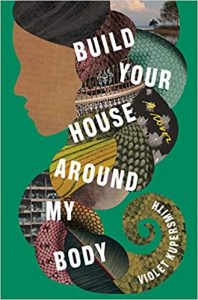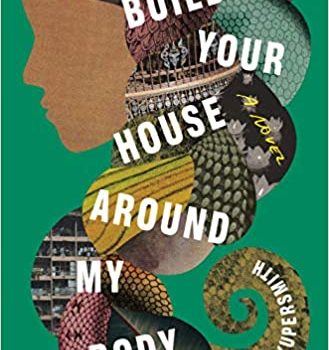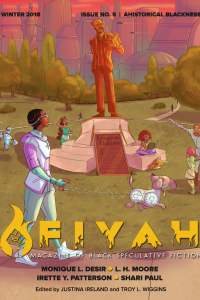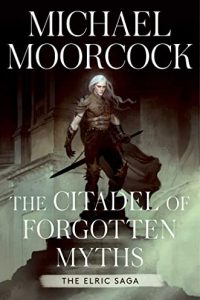Ian Mond Reviews Build Your House Around My Body by Violet Kupersmith
 Build Your House Around My Body, Violet Kupersmith (Random House 978-0-81299-332-5, $27.00, 400pp, hc) July 2021.
Build Your House Around My Body, Violet Kupersmith (Random House 978-0-81299-332-5, $27.00, 400pp, hc) July 2021.
Violet Kupersmith’s debut novel, Build Your House Around My Body, is a beautifully wrought, non-linear tale of ghosts, missing girls, and revenge set against the backdrop of colonial and post-colonial Vietnam. It’s not a spoiler to say that one of those disappearing girls is Ngoan Nguyen (though she prefers to go by “Winnie”). We’re made aware of this from the very first chapter heading – “June 2010, Saigon, Nine Months Before Winnie’s Disappearance” – and subsequent chapters set during the days, months and years preceding Winnie’s disappearance, as well as a handful that take place after she vanishes. Initially, this foreknowledge lends the novel an uneasy and sinister atmosphere. But as we dive deeper into the story, a narrative that spans seven decades and takes us from the centre of bustling Saigon to the haunted forests and rubber tree plantations of the Vietnamese countryside, Winnie’s disappearance becomes background noise. The book’s structure – the story is told out of order – certainly plays into this; still, the real stroke of genius, and why I found myself falling in love with Build Your House Around My Body, is that Kupersmith’s subtle skill of drawing our focus away from Winnie’s inevitable fate also matches Winnie’s desire to fade into the scenery.
We first meet Winnie on her arrival in Vietnam. Although she never fully articulates why she has travelled from America to her father’s birthplace (Winnie is biracial; her mother is white), what does become clear is her low sense of self-worth.
She had assumed that one day she would fill all of [the space in her suitcase]. That her life would provide things worth keeping. That she herself would become someone worthy of being kept. But now, she feared that she had jinxed herself. Her arrogance had earned her the ire of a fickle god, and her life would continue to be as empty as her luggage, wherever she went.
Winnie’s confidence and self-image take a further battering at her great-aunt’s home, where she is treated like a ghost by her two cousins and at the Achievement! International Language Academy, where Winnie teaches English (not very well), and where she is regularly confused with another American-Vietnamese teacher named Dao. “[Dao’s] Vietnamese was superior, her feet were smaller, her complexion was brighter, and her boobs were perkier.” It’s concerning the latter – her vague physical resemblance to Dao – where Winnie’s longing to blend into her surroundings becomes evident. While she does hate being confused with her colleague, her employer’s inability to tell the two of them apart means she can slack off at her job without fear of reprisal. And yet, as Winnie’s stay in Vietnam extends beyond three months, what was originally a strategy to hide her poor teaching performance becomes a part of who Winnie is. She chooses clothing (“body obfuscating sack dresses”) and a hairstyle (“raggedy monk hair”) that not only renders her sexless but makes her invisible to both strangers and the people she works alongside.
The one person who does notice Winnie is Long, the office administrator at the school. Winnie finds Long’s interest in her surprising (“she knew she was not pretty enough to warrant it”). But so desperate is she to get out of her current accommodation with the Cooks – Kupersmith’s hilarious depiction of white liberal Americans, with their holier-than-thou, passive-aggressive attitude toward those (like Winnie) who don’t meet their high-minded standards – she decides to move in with him, and they become lovers (of sorts). Long, in the first instance, is presented as a bit character, the “concerned boyfriend” who realises that Winnie is missing. But as the narrative ricochets through time, we begin to understand that Winnie is the minor player in Long’s story and that of his police-officer brother Tan and the woman they both loved, Binh. Their tale begins two decades prior where, growing up in the highland village of Ia Kare, the three childhood friends encounter a nightmarish creature – a man wearing a suede cowboy hat whose jaw can unhinge like a snake. Long and Tan run for their lives, but Binh, who from a young age realised “fear was rarely useful,” stands her ground as “slightly stinky smoke” trickles from the man’s gaping maw. It’s a terrific set-piece, one of many in the novel involving the man with the cowboy hat, who we will come to know as the Fortune Teller. The scene also vividly establishes the relationship between Tan, Long, and Binh, the brothers besotted and intimidated by their fiery and strident friend and her unwillingness, as they get older, to reciprocate their feelings. Unlike Winnie, Binh’s disappearance is not foreshadowed at the top of each chapter, and yet it’s her disappearance that the plot ultimately pivots around.
As much as I’m a sucker for the sort of non-linear narrative where a throwaway line or ancillary character grows in importance as more of the story is revealed (Kupersmith acknowledges David Mitchell as an influence on her work), it’s not the only thing that makes Build Your House Around My Body such a fantastic book. For one, it’s a novel that deals passionately with several themes, whether it’s Winnie’s struggle with her identity, or Binh’s independence and her refusal to be boxed in by the men in her life, or the shaping of Vietnam by the figurative and literal ghosts of its French colonial past. And, while I can’t speak to Kupersmith’s characterisation of Vietnamese folklore, her use of smoke spirits that manipulate people and animals as flesh puppets coupled with the preponderance of snakes (something to keep in mind if slithery reptiles bother you) make for a dark fantasy that’s truly chilling and creepy. In a year where the ongoing, depressing reality of COVID has made it challenging to escape to other places and other worlds, I had no such trouble with immersing myself in Violet Kupersmith’s wonderful debut novel.
Ian Mond loves to talk about books. For eight years he co-hosted a book podcast, The Writer and the Critic, with Kirstyn McDermott. Recently he has revived his blog, The Hysterical Hamster, and is again posting mostly vulgar reviews on an eclectic range of literary and genre novels. You can also follow Ian on Twitter (@Mondyboy) or contact him at mondyboy74@gmail.com.
This review and more like it in the December 2021 issue of Locus.
 While you are here, please take a moment to support Locus with a one-time or recurring donation. We rely on reader donations to keep the magazine and site going, and would like to keep the site paywall free, but WE NEED YOUR FINANCIAL SUPPORT to continue quality coverage of the science fiction and fantasy field.
While you are here, please take a moment to support Locus with a one-time or recurring donation. We rely on reader donations to keep the magazine and site going, and would like to keep the site paywall free, but WE NEED YOUR FINANCIAL SUPPORT to continue quality coverage of the science fiction and fantasy field.
©Locus Magazine. Copyrighted material may not be republished without permission of LSFF.








